Patal Bhuvaneshwar is Patal Bhuvaneshwar is one of the most mysterious and spiritual place of Uttarakhand. This is a limestone cave situated 13kms from Gangolighat in the Pithoragarh district of Uttarakhand state. This is a limestone cave temple dedicated to Lord Shiva. It is said that this underground cave first was discovered by a king in Treta Yug. This underground cave is the residence of Lord Shiva and thirty three crore deities (33 crore types of gods in Hindu culture). This temple is said to be one of the most blessed temple of Lord Shiva and yields a hundred times the fruit of prayer at Kedarnath, Baidyanath or Kashi.
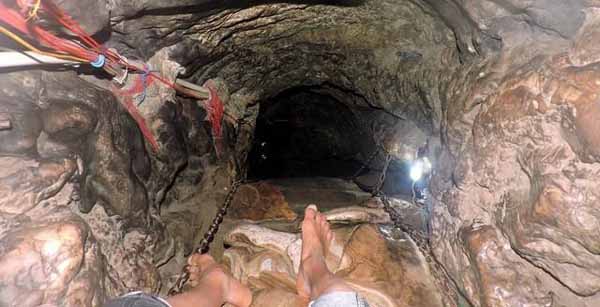
This cave length is about 160 meters and the depth is 90 feet. The temple is situated in the Bhubneshwar village at an altitude of 1350 m above sea level. The construction of limestone cliffs has created various spectacular stalactite and stalagmite shapes of different colors and forms. The path of this is like a narrow tunnel that leads to many caves. This cave is going to open like a narrow tunnel that leads to many caves. The cave is fully electrically published. Built in the flow of water, Patal Bhubaneswar is a series of caves within the caves. Patal Bhuvaneshwar is surrounded by lofty peaks of Himalayan range.
Legend Of the Cave
According to faith King Rituparna of the Surya Vansha discovered the cave in 'Treta yug'. The story starts with Ritupurna and King Nala. It is said that once, King Nala was defeated by his wife, Queen Damayanti. In order to escape his wife’s prison Nala requested Ritupurna to hide him. Ritupurna took him to the forests of the Himalayas and asked him to stay there. While going back home he was fascinated by a deer which ran into woods and went after it. He could not find it and took rest under a tree. He had a dream where the deer was asking Ritupurna not to chase him. His sleep broke and as he woke up and went to a cave where a guard was standing. After enquiring about the cave he was allowed to go inside. Right at the entrance, Ritupurna met Sheshnag who agreed to take him through the cave.
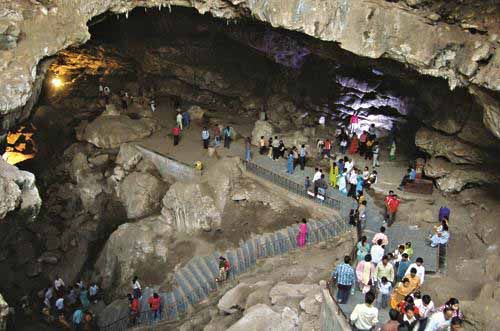
It carried him on its hood. He saw the marvels of Gods taking place inside. He saw all the 33-koti (33 types of god not 33 cror ) gods and goddesses including Lord Shiva himself. It is said that after his visit, the cave was closed for ages with a slight prediction in the Skandpurana that it will be reopened again in Kaliyuga. Shankarcharya in Kalyug, during his visit to Himalayas re-discovered this cave. Since then regular worship and offering are being done at this place.
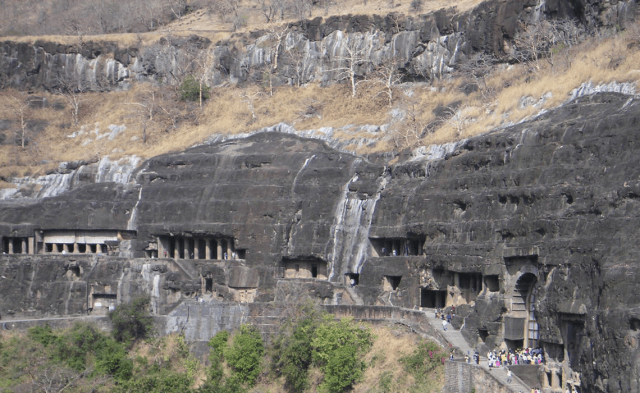
Patal Bhuvaneshwar is not just one cave, rather a cave city. There is a 1 km long cave in Patal Bhuvneshwar. This is 90 feet below the ground level. Caves within caves, steps leading to another, each one unmasking deep secrets from within. The motorable road ends half a kilometer away from the cave entrance. You have to descends nearly 100 steps into this narrow cave, to reach the sanctum sanctorum, which gives an overwhelming feeling that you’re entering the centre of the earth. Each stone, each stalagmite within each cave or doorway, in magnificent erection revels the story of Hindu pantheon in the shapes of Gods, Goddesses, saints and known mythological characters.
HISTORY OF PATAL BHUVANESHWER
In the heart of the village of Patal Bhuvaneshwar is a cave and first man to find this cave was Raja Rituparna who was the king of the Sun Dynasty who ruled Ayodhya during the ' Treta Yuga'. Legend and folklore have it that this underground cave enshrines Lord Shiva and thirty three crore (330 million) Gods. As per believe, some caves which are now closed were opened thousand of years back. It is yet not been fully explored. It is also believed that this cave is internally connected to the four abodes / seats (Char Dham) and underground route to Mount Kailash. Adi Shankaracharya visited this cave in 1191 AD. That was the beginning of the modern pilgrimage history, The way to the Patal Bhuvaneshwar cave goes through a long and narrow tunnel. Other than Lord Shiva the forms of Sheshnag, Kal Bhiarav, Ganesha and several other gods can be seen in Patal Bhuvaneshwar. It is believed that the cave is the abode of 33 crore Gods and Goddesses.
Patal Bhubaneshwar Mythological History :
According to the Puranas, there is no place other than Patal Bhubaneswar where the four dhams are seen together. This sacred and mysterious cave itself has centuries of history. It is believed that 33 crore deities have made their abode in this cave. It is written in the Puranas that in the Treta Yuga, this cave was first seen by King Ritupurna, in the Dwarpara Yuga, the Pandavas had played Chaupar with Lord Shiva and in the Kalyuga, Jagat Guru Shankaracharya was interviewed from this cave around 1191 AD. He: Established a Shivling of Tambe. After this, some of the kings discovered this cave. In today's time, Patal Bhuvaneshwar Cave is the center of attraction for visitors. Many tourists from abroad come to visit this cave
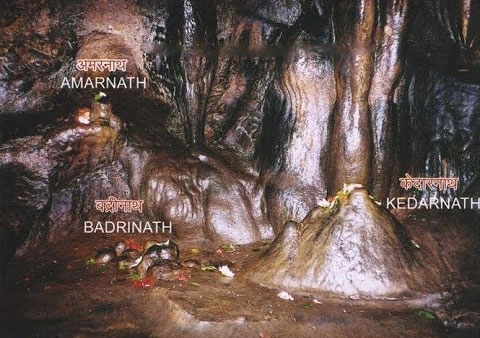
Values and FeaturePatal Bhuvaneshwer :-
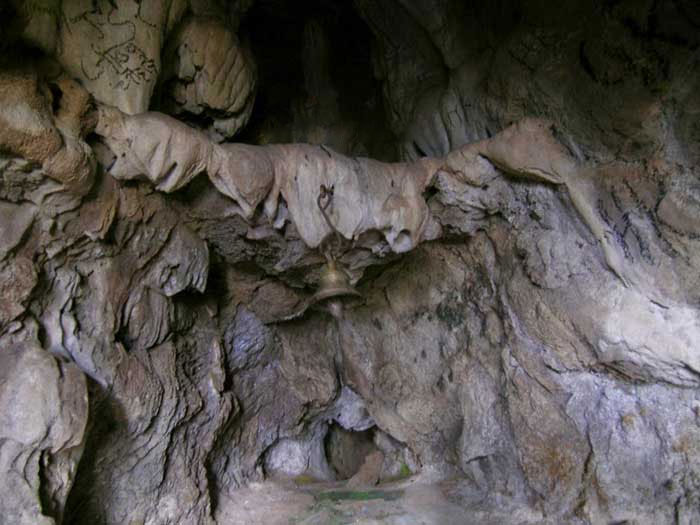 In Hinduism, Lord Ganesha is considered the first worshiper. There are many stories about the birth of Ganesha. It is said that once Lord Shiva had beheaded Ganesha in anger, later Lord Ganesha was put on the head of an elephant at the behest of Mata Parvatiji, but who is believed to have been separated from the head. That Lord Shiva has kept that head in the Patal Bhuvaneshwar cave. In the cave of Patala Bhubaneswar there is a rock in the form of Brahmakamal, a 108-petal crematorium, on top of the idol of Lord Ganesha. From this, water from Brahmakamal drips a divine drop on the sculpted head of Lord Ganesha. The main drop is seen falling in the mouth of Adiganesh. It is believed that this Brahmkamal was established by Lord Shiva here.
In Hinduism, Lord Ganesha is considered the first worshiper. There are many stories about the birth of Ganesha. It is said that once Lord Shiva had beheaded Ganesha in anger, later Lord Ganesha was put on the head of an elephant at the behest of Mata Parvatiji, but who is believed to have been separated from the head. That Lord Shiva has kept that head in the Patal Bhuvaneshwar cave. In the cave of Patala Bhubaneswar there is a rock in the form of Brahmakamal, a 108-petal crematorium, on top of the idol of Lord Ganesha. From this, water from Brahmakamal drips a divine drop on the sculpted head of Lord Ganesha. The main drop is seen falling in the mouth of Adiganesh. It is believed that this Brahmkamal was established by Lord Shiva here.
Best time to Visit Patal Bhuvaneshwar :-
Patal Bhuvaneshwar is a picturesque destination affording enchanting views throughout the year. The best time to visit Patal Bhuvaneshwar is from April to June and from Mid September to October end. Summers in Patal Bhuvaneshwar :- The weather of Patal Bhuvaneshwar remains salubrious during summers and you can see unobstructed views of the Himalayas. Patal Bhuvaneshwar remains pleasant during summers and light woollens are required. It is probably the best time to visit Patal Bhuvaneshwar.
Temples Near Patal BhuvaneshwarTemples :
- Mahakali Temple of Gangolihat.
- Mostamanu temple.
- Nagmandir of Berinag.
- Ghunsera Devi Temple.
- Kedar temple.
- Nakuleshwar Temple.
- Kapileshwar Mahadev cave temple.
- Arjuneshwar Shiva temple.
- Kot Gari Devi
- Ulkadevi Temple
How to reach :
The motorable road ends half a kilometer away from the cave entrance. You have to descend nearly 100 steps into this narrow cave, to reach the sanctum sanctorum, which gives an overwhelming feeling that you are entering into the center of the earth.
How To Reach Patal Bhuvaneshwar Air: The nearest airport is Naini Saini at Pithoragarh (91 kms). No regular flights are available at present.
How To Reach Patal Bhuvaneshwar Rail: The nearest Railhead is Kathgodam, 192 kms. with train connections from Delhi, Kolkata, Lucknow, Dehradun and Mathura.
How To Reach Patal Bhuvaneshwar Road: Patal Bhuvaneshwar is connected through metalled hill roads to tourist destination like Almora, Binsar, Jageshwar, Kausani, Ranikhet, Nainital with all the major towns in the area.
Patal Bhuvaneshwar is situated about 37 km from Chaukori and 14 km from Gangolihat in Pithorgarh district in Uttaranchal.
Kathgodam – Almora – Patal Bhuvaneshwar by car 192 kms time duration is around 6-7 hours. Patal Bhuvaneshwar – Jageshwar - Kathgodam by car 200 kms 7-8 hours.
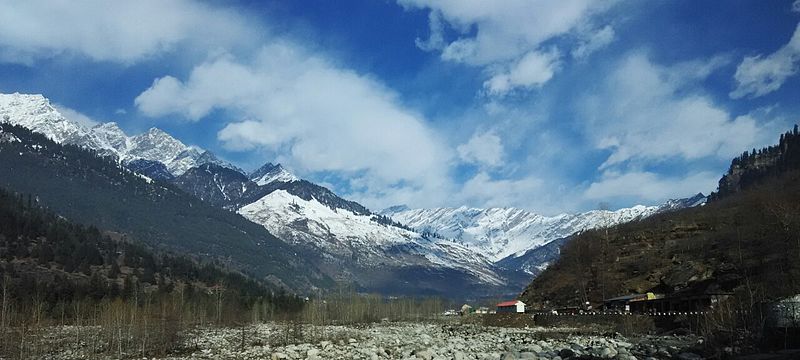













 In Hinduism, Lord Ganesha is considered the first worshiper. There are many stories about the birth of Ganesha. It is said that once Lord Shiva had beheaded Ganesha in anger, later Lord Ganesha was put on the head of an elephant at the behest of Mata Parvatiji, but who is believed to have been separated from the head. That Lord Shiva has kept that head in the Patal Bhuvaneshwar cave. In the cave of Patala Bhubaneswar there is a rock in the form of Brahmakamal, a 108-petal crematorium, on top of the idol of Lord Ganesha. From this, water from Brahmakamal drips a divine drop on the sculpted head of Lord Ganesha. The main drop is seen falling in the mouth of Adiganesh. It is believed that this Brahmkamal was established by Lord Shiva here.
In Hinduism, Lord Ganesha is considered the first worshiper. There are many stories about the birth of Ganesha. It is said that once Lord Shiva had beheaded Ganesha in anger, later Lord Ganesha was put on the head of an elephant at the behest of Mata Parvatiji, but who is believed to have been separated from the head. That Lord Shiva has kept that head in the Patal Bhuvaneshwar cave. In the cave of Patala Bhubaneswar there is a rock in the form of Brahmakamal, a 108-petal crematorium, on top of the idol of Lord Ganesha. From this, water from Brahmakamal drips a divine drop on the sculpted head of Lord Ganesha. The main drop is seen falling in the mouth of Adiganesh. It is believed that this Brahmkamal was established by Lord Shiva here.